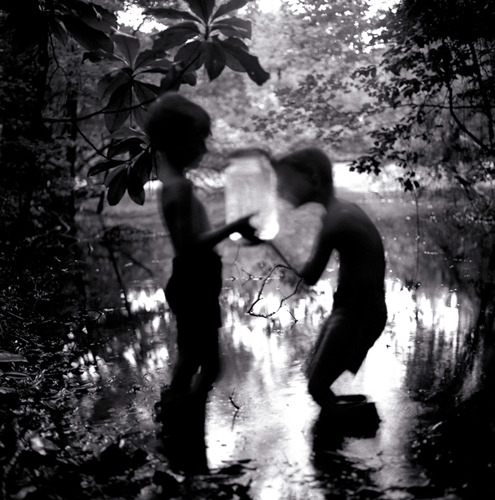A lot of the respect I have for artists comes from the effort that goes into their work, and the amount of work that must have gone into an image like this is incredible. I think that most people would have just made one of the cats, tossed it on a stand and called it finished. However Skoglund went through the effort of having this entire image created before she even pulled out the camera. In terms of imagery, I love the chaotic effect that the marauding cats seem to have. The way they interact with the rest of the set makes them appear to be alive and moving. The use of color is also very strong; obviously the colors were not random luck and were deliberately put into the set for a purpose. I feel as though the grey gives the objects a dead look, allowing the cats to be the real life of the shot.
More cats, though this time, not nearly as successful. Honestly, this one looks like a bad photoshop job. I know that the color of the cats is real because they are the same cats that are in the other shot, but the blue of the world around is probably done with photoshop. Also, the photo doesn't have the same feeling of widespread chaos as the other one. The fact that the cats are all with in the frame makes it seem like you are seeing all of them; it has none of the implied 'more to come' that the other one holds. Finaly, the clutter of the city takes away from the clutter of the cats. It seems almost normal, which is contrary to everything that Skoglund does.
This image stood out to me because of the apparently natural environment. There is no color manipulation, no posed people, it just seems to be a bunch of large blue leaves in a field. Typical Skoglund stuff. I really enjoy the implied narratives that show up in all of her work. This one for example seems to be leading some where and coming from some where else. Though we can probably see all of the leaves, it seems like they could go on for ever in either direct, "as far as the eye can see" as the title puts it. The use of the borders and grass to cut of the leaves before they end allows for the effect, adding an element of mystery to the already strange scene. These are all elements I am trying to focus on in my own work. As I construct sets, I want them to look like they are part of a larger world and not contained by the frame. I want the mystery of a before and after to show just as much as it does in Skoglunds work.











